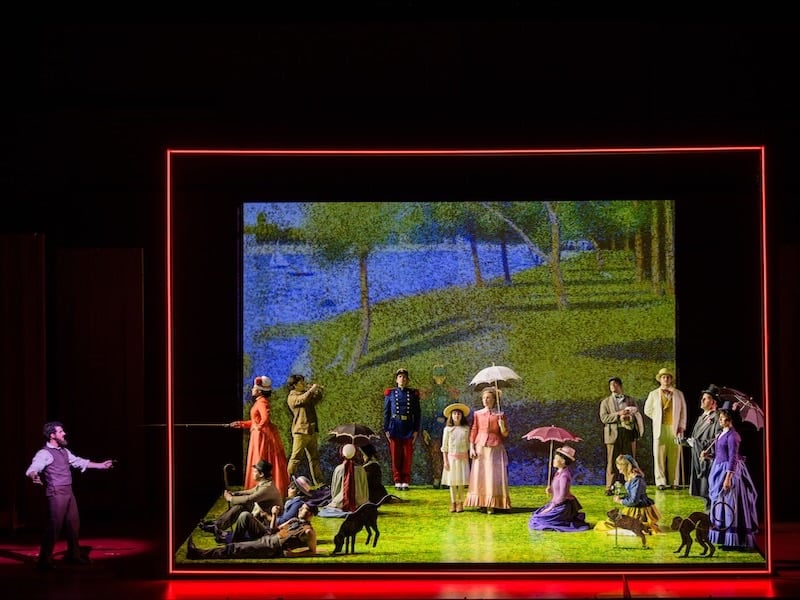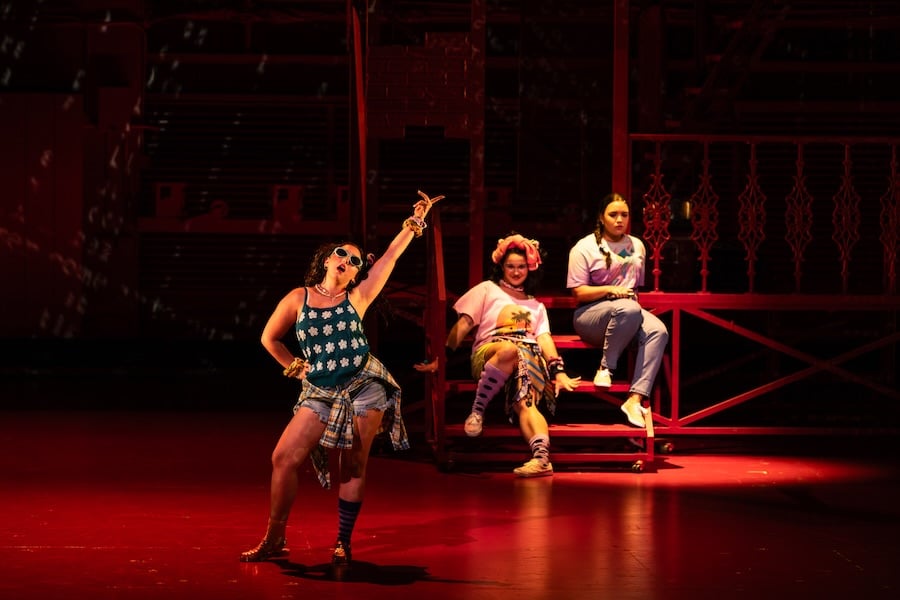It was 50 years ago that Glimmerglass Opera Festival first opened and helped ignite a movement that would redefine what was to be American opera and music-theater. Nestled on the north end of Otsego Lake, better known as Glimmerglass, just outside of Cooperstown, New York, the ideal setting draws in world-class artists and provides a summer program for emerging singer-actors and dancers to gain professional credits and work beside luminaries across the spectrum of music-theater.
Robert Ainsley began his tenure as Artistic and General Director in September 2022 when, after 12 years, the previous AD Francesca Zambello turned it over to her esteemed colleague to devote her energies fulltime at the helm of the Washington National Opera. Ainsley, with his youthful effervescent energy and welcoming grin, is just the ticket to overcome any doubts or naysaying regarding the future of opera and the arts. “Hello, Glimmerglammers! My GlimGlam Fam!” he bounds onto the stage before every performance and greets the audience, seeming genuinely glad to see us all. His is a winning strategy; to date he has surpassed the festival’s anniversary goal of raising five million dollars by almost two million, so he has just raised the bar.
More than anything, Glimmerglass means community.
Artistically, this important anniversary season serves as a tribute to legendary Scene Designer John Conklin, who as Associate Artistic Director Emeritus was part of the Glimmerglass familia for many years. He returned this season to design all four big productions, and it was said that the man was never happier than hunched over his design desk at Glimmerglass, most recently with Glimmerglass Director of Productions Abby Rodd. It is such a shame he did not make it this summer to even one opening but died while everything was still in rehearsal. But one has to believe John is still hanging out, smiling down on the art and his fellow art makers.
Conklin took an integrated approach to designing the season’s shows in both color palette, where he chose to explore the many symbolic meanings of the color red, and by incorporating a series of reveals where, in cloths being pulled down or away, something startling and new is discovered. Nowhere was his genius more in evidence than in the bold, colorful neighborhood he created for the world premiere production of The House on Mango Street. Three-story bright red scaffolding units served as fire escapes of an urban universe defined by one neighborhood block. Wheeled in and out as needed, the set pieces also provided surfaces for colorful projections including sequined bespangled events as you might find spilling out across a crowded street during a Hispanic street festival. Visual elements also include gigantes, the giant Mexican puppets, mixing realistic street scenes with pure theatrical magic.

There is an interesting pairing going on this season with a show about another neighborhood “across the pond.” Ethan Heard directed this new production of Stephen Sondheim and James Lapine’s iconic musical about the Parisian painter Georges Seurat, Sunday in the Park with George, and both staging and design took a pared-down, minimalist approach. Heard had the cast sitting in straight chairs lining the sides of the stage and only stepping in and out of the “frame” as needed, and the space was marked by a central rectangular platform in Conklin’s signature red (natch). But when the red cover was pulled off, the green baize-form, smaller than a putting green, served symbolically as La Jatte, the island in the middle of the Seine where Seurat imaginatively captured ordinary people on their ordinary Sundays taking their promenades. The artist placed them forever together in a dancing field of light, using painted dots and specks of commas in a technique which became known as pointillism.
To capture Seurat’s large ensemble of characters in his painting, Sondheim writes for multiple voices, giving many resident members and guest artists of the Glimmerglass company cameo moments in which to shine. Taylor-Alexis DuPont etches a most memorable character as the much put-upon companion Nurse to the Old Lady, played with comic perfection by Luretta Bybee, and I was tickled mightily by the American couple from the South, Betty and Bob Greenberg (Claire McCahan and Marc Webste), who no sooner arrive in Paris than they want to go home. There’s much playful silliness between Angela Yam and SarahAnn Duffy as the two mademoiselles, following their flirtation with two young soldiers, one of them made out of cardboard. And who can resist Erik Nordstrom as the lounging, grouchy Boatman who prefers the company of his dog to humans? Indeed, there are a lot of recognizable types on the island.
John Riddle is a singer-actor who is able to give us the thorny complexity of a singularly-focused “genius,” who can break down and reel off the elements in art-making but emotionally is not able to connect to people, not even Dot, the woman he loves, nor his daughter as she’s coming into this world, whom he can’t acknowledge nor make room for in his cerebral-channeled life. It is left to Dot, model and muse, to provide human connectivity and emotion, and Marina Pires gives us all that and more in a beautiful portrait of a woman who can also teach us how to “move on.”
One other powerful aspect of this production is how Act II — which has often, sadly, received much criticism, with its “hundred years later” conceit and shuffling of characters — really works in this production. Heard makes a case for the possibility of generational maturing and healing. Even the initially chromelume-fixated, society/success-chasing George gets an aha moment, and we are led to believe he will mend his ways and work to find balance between art and life that his great-grandfather and namesake never could by going for saying what is true and heartfelt.

When we turn to the slot for a truly contemporary work in this season’s lineup, we can cheer the choice at this time in our country’s struggle to define who we are and want to be that Glimmerglass would commission and feature the world premiere of Sandra Cisneros’ coming-of-age story of about a young Chicana! “I like to tell stories,” sings the protagonist Esperanza, mouthpiece for Cisneros’ revisiting of her childhood and the struggle to claim her own voice through her writing.
Cisneros co-wrote the libretto for her story with Composer/Librettist Derek Bermel. She has indeed captured much of the strength, layering, and complexity of emotions found in the novel, in not only the psychology of her fiercely independent protagonist but by bringing in all the quirky neighbors in this their shared universe bound by one city block.
The music in the opera takes its wide-ranging cues from many cultural sounds in play today, from opera to Broadway, and from Latin dance rhythms and norteño to pop and hip hop. One thing the team hadn’t got quite right yet opening night was the balance between the orchestra and the changing sound worlds displayed by the singers, and, sadly, thus much of the sung text got lost. It’s a tricky mix with the powerful acoustic vocal music associated with opera and the mix of spoken word and rhythmically produced pop-belt-and-screlting mix explored in much of today’s electronic music amplification. Although I can certainly appreciate the premise of the creative team to capture accurately the diversity and constantly “changing channels” of our urban soundscapes, it was sometimes a challenge to re-tune one’s ears to the different musical genres and vocal styles coming at us veritably simultaneously. I would advocate a second and even a third viewing and listening to Mango Street as the production settles into itself. Every new work, after all, deserves our attention, working to meet it where it lives.
There were indeed moments of power and beauty. Angelo Silva as Geraldo, pushing a shopping cart on and off the stage, represents the most marginalized in the community, in his case an undocumented street vendor. Silva’s glorious voice is set beautifully by Bermel in a show-stopping number, and Geraldo’s story breaks open our hearts in the way only opera can. The violence that so suddenly ends the character’s life ripped me apart. Taylor Alexis-Dupont, as Sally, an adolescent girl with a terrible secret in her family and someone who wants to run with the wild boys and “take her cake and eat it too,” has a powerful instrument and knows how to fill and shape emotions to full advantage. There is also a gorgeous adult quintet (sextet?) by the adults in the beginning of Act II when they sing “Once” (when I was beautiful), comparing their individual dreams of what their lives would be but dreams always deferred. Amanda Castro has choreographed some cool street dancing.
Mikaela Bennet as the central character possesses genuine vocal warmth and clarity, especially in her upper range, but just because she can land strong notes at the bottom doesn’t mean that composers like Bermel need to make songs Olympic events in terms of degrees of difficulty. (There’s too much of this kind of vocal composition going on these days, to my mind.) Such vocal gymnastic displays can distract from the emotional impact of what’s happening at any moment in the story.
Nonetheless, these two shows really do serve as a pair, scenically and musically being in conversation, thanks not only to Conklin’s savvy, resonating designs but also to the conducting. Micael Ellis Ingram for the Sondheim brings out the “minimalist grooves” in the school of John Adams/Phillip Glass as well as “achingly beautiful” Fauré like harmonies. For Mango Street, Nicole Paiement is fearless in her approach. She reminds us that we are all shaped and enriched by our neighborhoods, its sounds and rhythms.
I left both shows thinking about neighborhoods as community. Neighborhoods feed images and stories to their artists — in one case George the Parisian painter and in the other a young Chicana who is in the process of becoming a writer and storyteller for her people. And we need our artists to show us who we are and what we can be. Yes, surely, sometimes in the process we get bruised or broken but only broken open, and if we can learn and forgive, so we can grow. Neighborhoods remind us that we must embrace new stories and new voices all around us, stories that have much to teach and entertain us if, like Dot, we care enough to connect.
Sunday in the Park with George (plays through August 17, 2025)
Running Time: Two hours and 47 minutes with a 25-minute intermission.
George – John Riddle
Dot/Marie – Marina Pires
Old Lady – Luretta Bybee
Nurse – Taylor-Alexis Dupont
Boatman – Erik Nordstrom
Celeste #1 – Angela Yam
Celeste # 2 – SarahAnn Duffy
Conductor – Michael Ellis Ingram
Director – Ethan Heard
Set Designer– John Conklin
Costume Designer – Beth Goldenberg
Lighting Designer – Amith Chandrashaker
Movement Director – Madison Hertel
Projections Designer – Greg Emetaz
Sound Designer – Joel Morain
Hair & Makeup Designer – Tom Watson
The House on Mango Street (plays through August 16, 2025)
Running Time: Two hours and 17 minutes with a 25-minute intermission.
Esperanza – Mikaela Bennett
Geraldo – Angelo Silva
Sally –Taylor-Alexis DuPont
Lucy –Samantha Sosa
Rachel – Kaylen Hernandez
Mama Cordero – Deborah Nansteel
Papa Cordero – Sergio Martinez
and for the complete cast list go to the Glimmerglass website
Conductor – Nicole Paiement
Director – Chía Patiño
Set Designer – John Conklin
Costume Designer – Erik Teague
Lighting Designer – Amith Chandrashaker
Choreographer – Amanda Castro
Dramaturg – Kelley Rourke
Projections Designer – Greg Emetaz
Hair & Make-Up – Tom Watson
Tickets are available at glimmerglass.org.
SEE ALSO:
2025 Glimmerglass Festival Review: ‘The Rake’s Progress’
2025 Glimmerglass Festival Review: ‘Tosca’
(reviews by Susan Galbreaith)



